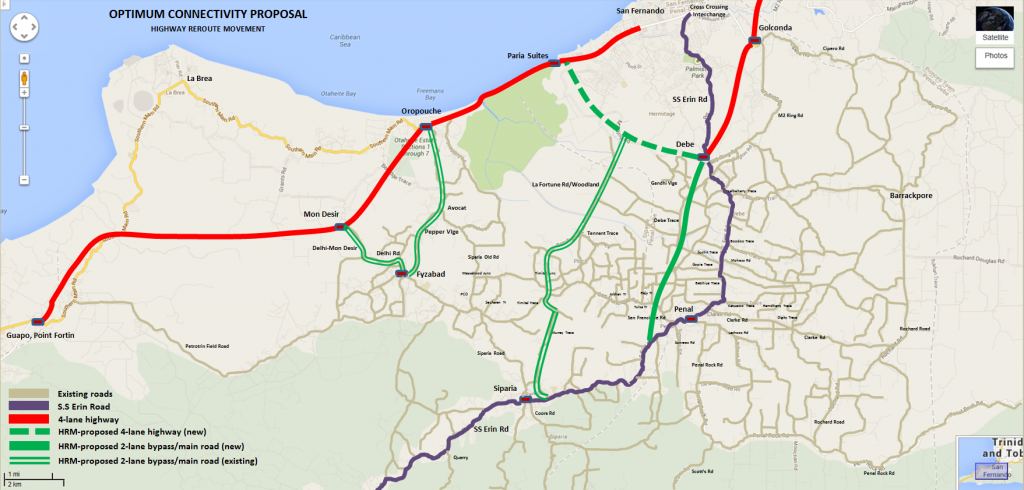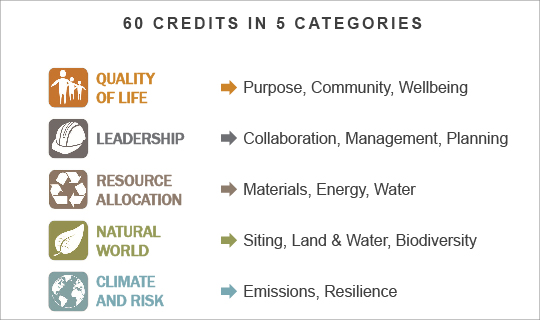Before you read this, Sign this petition: PM Kamla Persad-Bissessar: Halt Works and Conduct Independent Technical Review
Famed mas maker from Trinidad and Tobago, Peter Minshall, released this video on September 27th, 2014. In 5 minutes he uses a model and storytelling to simply question an engineering design that takes material from a mountain miles away to fill in part of a lagoon for a segment of a highway that the Highway Reroute Movement is against. The communities against this section of the highway wish less destructive options that improve existing roads, preserve their homes, families and livelihoods (see Figure 1 below for one option of an Optimum Connectivity Proposal and see this video describing the new proposal). An independent review committee submitted a report, known as the Armstrong Report, in March 2013.
It concludes, “The Trinidad and Tobago Constitution guarantees certain rights and freedoms which are considered fundamental to the operation of a democratic society. Section 4 of the Constitution guarantees the right of enjoyment of property and the right not to be deprived thereof except by due process of the law. It follows that there is no breach of a person‘s constitutional rights if that person‘s property is acquired in strict compliance with the law and that such person receives adequate compensation, including consideration of trade-offs. A significant concern with the Debe to Mon Desir Highway is whether or not the lawful authority responsible for this large public expenditure is conforming to due process, including observance of various oversight statutory requirements for environmental management, the development of land, and due consideration of socio-economic impacts of the affected persons.
The HRC found that there were significant shortcomings which warrant further interrogation to determine the way forward. The complex and sensitive issues involved in this project certainly could not be addressed within the confines of this 60-day review period. Should the Government decide to proceed with the construction of the Debe-Mon Desir segment, the HRC is of the considered opinion that shortcomings resulting from the inadequacies of proper assessment of the likely impacts on the human and natural environment must first be determined and resolved.”
The Highway Reroute movement in Trinidad and Tobago is championed by many, including a University of the West Indies lecturer Dr. Wayne Kublalsingh. Today he fights to survive with no water or food since September 17th, 2014. His second hunger strike over this highway from Debe to Mon Desir. His request? That the Prime Minister meets with the Highway Reroute Movement to address issues highlighted by the Armstrong report.
Figure 1: The Optimum Connectivity Proposal – an option proposed as an alternative to the contracted highway from Debe to Mon Desir.
This week I spent 3 days at the WEFTEC® 2014, the Water Environment Federation’s Annual Technical Exhibition and Conference held in New Orleans, Louisiana. With ~20,000 professionals from the water and wastewater sector, the experience was eye opening, inspirational, and a great learning experience. One of the sessions that I attended focused on sustainability certification for infrastructure projects. A joint collaboration between the Zofnass Program for Sustainable Infrastructure at the Harvard University Graduate School of Design and the Institute for Sustainable Infrastructure, WEFTEC is exploring the use of the Envision™ Sustainable Infrastructure Rating System. The Institute for Sustainable Infrastructure is a not-for-profit education and research organization founded by the American Public Works Association, the American Council of Engineering Companies and the American Society of Civil Engineers.
The rating system is designed to help users identify ways in which sustainable approaches can be used to
- plan
- design
- construct
- operate
- maintain
- deconstruct/decommision infrastructure projects
Infrastructure projects include those related to energy, water, waste, and transport. The Envision™ structure includes the following 5 categories and 14 sub categories:
Figure 2: Envision™ categories and sub categories.
Taken from http://www.hdrinc.com/sites/all/files/envision-2.jpg on 10/5/14
As engineering companies and our profession embrace sustainability the points raised by Minshall become very important. While his video makes a whole lot of sense – common sense, we have a bunch of questions and metrics that allow us to score projects and emerge with a value that ranks their level of sustainability. Questions like:
- Has the project team sought to align the project vision and goals to the needs and goals of the host and affected communities as well as address potential adverse impacts?
- To what extent has the affected communities been meaningfully engaged in the project design process?
- Has the project owner and the project team identified under-unused pathways, bikeways, rail and/or water modes of transportation that are unused, in disrepair and/or have barriers to safe use? Has the team sought to upgrade these elements and integrate them into the existing transportation infrastructure?
- To what extent does the final design address views and local character?
- To what extent have the owner and project team reduced the net embodied energy of vhe project?
- Has the project team defined a sound and viable sustainable procurement program?
- To what extent has the project team specified locally sourced materials, plants, aggregates, and soils?
- Is the project located on a site that neither contains nor is located within the specified distance of vernal pools, wetlands, shorelines, or water bodies unless located on a previously developed site?
These questions align with various subcategories. They require a certifying body to check reports, meeting minutes etc.. A number is assigned depending on the answer given. That contributes to the final score which then determines the overall grade and rating. Companies pay to get this done. In societies where Energy Star compliance equipment is now the desired product for customers because of the reduced electricity bills one can expect, the Envision™ certification aims to be the desired stamp for infrastructure that we depend on so much.
So, when one looks back at the documents needed to answer some of those questions they will find the Highway Reroute Movement. They will find the hunger strikes of Dr. Kublalsingh, they will find the petitions for Prime Minister Kamla Persad-Bissessar to meet with the group and consider their Optimal Connectivity Plan. They will see the letters written supporting this plan (e.g. Paula Lucie Smith). They will hear the voices of Mr. Siew and others from the affected communities. They will hopefully not find the funeral announcement of Dr. Kublalsingh. They will find the youtube videos of citizens and artists like 3 Canal (Let good Sense Prevail – 2012), Amilcar Sanatan (5 minutes for Kublalsingh – Reasonings) asking for the government to consider the Optimum Connectivity Proposal. The sole contractor OAS (Construtora OAS S.A.) should not want that in this globally competitive world. Nor should the firms like ARUP Consultants, CH2MHill and AECOM, all contracted by OAS Construtora.
Useful Links:
Highway Reroute Movement FB page
Videos
Dr. Kublalsingh’s 1st Hunger Strike (3 Canal)
If I was the Prime Minister by Gabrielle Hosein
Optimum Connectivity Proposal (animation describing one proposed alternative for the Debe to Mon Desir project)
T&T Mash Up (Mr. Siew speaks about his community and the impact of the highway)
Peter Minshall – No More
From the Engineering site




